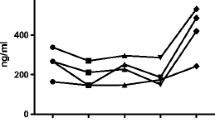Summary
The determination of the collagen crosslinks pyridinoline (Pyd) and deoxypyridinoline (Dpyd) seems to be a successful way of characterizing topic destructive processes in rheumatoid arthritis (RA). Dpyd is a specific marker of collagen I resorption in bone, whereas Pyd is released from types I and II collagen in bone and cartilage. Both crosslinks were examined in 38 RA patients concurrently by RP-gradient-HPLC in urine and serum. A positive correlation was found between the inflammatory activity (measured by CrP) and the level of collagen crosslinks in urine. A correlation between serum and urine concentrations was demonstrable for Pyd, but not for Dpyd. Different elimination kinetics for fragments containing either Pyd or Dpyd are a possible explanation for this observation. The ratio of Pyd/Dpyd is known to be a useful marker to distinguish between destruction of cartilage and bone collagen. Because the Pyd/Dpyd ratio in urine does not necessarily correspond to that in serum, probably as a result of metabolic or elimination processes, the usefulness of the relationship between the crosslinks in urine as a method of differentiating between cartilage and bone degradation must be questioned.
Similar content being viewed by others
References
Seibel M J, Zipf A, Ziegler R. Pyridinium-Crosslinks im Urin. Dtsch med Wschr 1994; 199: 923–9.
Campion GV, McCrea F, Schnitzer TJ, Lenz ME, Dieppe PA, Thonar EJMA. Levels of keratan sulfate in the serum and synovial fluid of patients with osteoarthritis of the knee. Arthritis Rheum 1991; 34: 1254–9.
Kleesieck R, Reinards R, Okusi J, Wolf B, Greiling H. UDP-D-xylose: proteoglycan core protein β-D-xylosyltransferase: A new marker of cartilage destruction in chronic joint diseases. J Clin Chem Clin Biochem 1987; 25: 473–81.
Mollenhauer J, Müller N, Thonar EJ. Neue Ansätze zur Labor-diagnostik der Osteoarthrose. Orthopäde 1990; 19: 1–8.
Seibel MJ. Komponenten der extrazellulären Gewebematrix als potentielle “Marker” des Bindegewebs-, Knorpel- und Knochen-metabolismus bei Erkrankungen des Bewegungsapparates. Z Rheumatol 1989; 48: 6–18.
Fife RS, Rachow JW, Ryan LM. Synovial fluid and plasma levels of cartilage matrix glycoprotein in arthritis. Calcif Tissue Int 1994; 55: 100–102.
Mansson B, Carey D, Alini M, Ionescu M, Rosenberg LC, Poole AR, Heinegard D, Saxne T. Cartilage and bone metabolism in rheumatoid arthritis. Differences between rapid and slow progression of disease indentified by serum markers of cartilage metabolism. J Clin Invest 1995; 3; 1071–7.
Poole AR, Dieppe P. Biological markers in rheumatoid arthritis. Semin Arthriti Rheum 1994; 23 (6); Suppl 2, 17–31.
Black D, Duncan A, Robins SP. Quantitative analysis of the pyridinium crosslinks of collagen in urine using ion-paired reversed phase high performance liquid chromatography. Anal Biochem 1988, 169, 197–203.
Seibel MJ, Robins SP, Bilezikian JP. Urinary pyridinium crosslinks of collagen specific markers of bone resorption in metabolic bone disease. Trends Endocrinol Metab 1992, 3, 263–70.
Chalkins E. Semi-quantitative criteria of estimating degrees of activity of rheumatoid arthritis. Committee Report to Am Rheum 1962, quot. by Lansbury In: Hollander JL, Mc Carthy D J Jr. (eds), Arthritis and Allied Conditions. Methods of evaluating rheumatoid arthritis. Lea and Febiger, Philadelphia, 1972, 419–38.
Larsen A, Dale K. Standardized radiological evaluation of rheumatoid arthritis in therapeutic trials. In: Dumande D C, Jasani J K (eds), Recognition of anti-rheumatic drugs. MTP Press, Lancester, 1978, 285–292.
Steinbrocker O, Traeger Ch, Baetterman R O. Therapeutic criteria for rheumatoid arthritis. JAMA 1949, 140, 659–62.
James I, Crowley C. Assay of pyridinium crosslinks in serum using narrow-bore ion-paired reversed-phase high performance liquid chromatography. J Chromatogr 1993, 612, 41–8.
Colwell A, Russel R G, Eastell R. Factors affecting the assay of urinary 3-hydroxy pyridinium crosslinks of collagen as markers of bone resorption. Eur J Clin Invest 1993, 23, 341–9.
Astbury C, Bird H A, McLaren A M, Robins S P. Urinary excretion of pyridinium crosslinks of collagen correlated with joint damage in arthritis. Br J Rheumatol 1994, 33, 11–5.
Spector T D, James I T, Hall G M, Thompson P W, Perret D, Hart D J. Increased levels of urinary collagen crosslinks in females with rheumatoid arthritis. Clin Rheumatol 1993, 12, 240–4.
Robins S P, McLaren A M, Nicol P, Seibel M J. Pyridinium crosslink measurements in serum and synovial fluid of patients with osteoarthritis. In: Keuttner K E, Schleyerbach R, Peyron J G, Hascall V C (eds), Articular Cartilage and Osteoarthritis. Raven Press, New York, 1992, 738–9.
Abbiati G, Rigoldi M, Frignani S, Colombo L, Mussini E. Determination of pyridinium crosslinks in plasma and serum by high-performance liquid chromatography. J Chromatogr 1994, B 656, 303–10.
Abbiati G, Bartucci F, Longoni A, Fincato G, Galimberti S, Rigoldi M, Castiglioni C. Monitoring of free and total urinary pyridinoline and deoxypyridinoline in healthy volunteers: sample realationships between 24-h and fasting early morning urine concentrations. Bone and Mineral 1993, 21, 9–19.
Seibel M J, Duncan A, Robins S P, Urinary hydroxy-pyridinium crosslinks provide indices of cartilage and bone involvement in arthritic diseases. J Rheumatol 1989, 16, 964–70.
Black D, Marabini M, Sturrock R D, Robins S P. Urinary excretion of the hydroxypyridinium crosslinks of collagen in patients with rheumatoid arthritis. Ann Rheum Dis 1989, 48, 641–44/
Kollerup G, Hansen M, Hørslev-Petersen K. Urinary hydroxypyridinium crosslinks of collagen in rheumatoid arthritis. Relation to disease activity and effects of methylprednisolone. Br J Rheum 1994, 33, 816–20.
Müller A, Hein G, Franke S, Herrmann D, Henzgen S, Roth A, Stein G. Quantitative analysis of pyridinium crosslinks of collagen in the synovial fluid of patients with rheumatoid arthritis using high performance liquid chromatography. Rheumatol Int 1996, 16, 23–8.
Author information
Authors and Affiliations
Rights and permissions
About this article
Cite this article
Hein, G., Franke, S., Muller, A. et al. The determination of pyridinium crosslinks in urine and serum as a possible marker of cartilage degradation in rheumatoid arthritis. Clin Rheumatol 16, 167–172 (1997). https://doi.org/10.1007/BF02247846
Received:
Accepted:
Issue Date:
DOI: https://doi.org/10.1007/BF02247846




